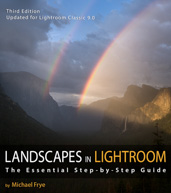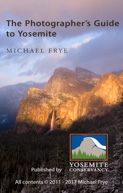by Michael Frye | Feb 25, 2012 | Yosemite Photo Conditions
On Thursday evening there was enough water to give Horsetail Fall a nice glow at sunset. Last night there wasn’t. Apparently nearly all the snow has melted on top of El Capitan, and it looks like the show is over for this year. Just wanted to let you all know in case you have plans to photograph it this weekend.
Bummer! Hope some of you got some nice images while it lasted.
—Michael Frye
by Michael Frye | Feb 22, 2012 | Announcements
In case you didn’t catch this yet, I was interviewed about Horsetail Fall for NPR’s All Things Considered yesterday. You can listen to the piece here. All I can say is that they did a good job of editing this! It was a lot of fun and quite an honor to be on this premier radio program.
—Michael Frye
by Michael Frye | Feb 21, 2012 | Yosemite Photo Conditions
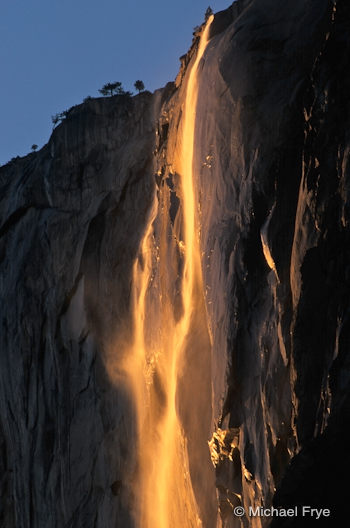
Horsetail Fall at sunset, February 1995
What makes Horsetail Fall so special? It seemed appropriate at this time of year to re-post this article from my 25 Years in Yosemite blog, where I talk about the photographic history of this waterfall, and the unique topography that creates the lighting phenomenon so many photographers have tried to capture:
Many people remember Yosemite’s firefall. On summer evenings from 1872 until 1968 the owners and employees of the Glacier Point Hotel pushed burning hot embers off the top of the Glacier Point cliff toward Yosemite Valley. The effect resembled a waterfall of fire. When the hotel burned down in 1969 the park service decided to end the ritual because this unnatural event caused visitors to trample meadows in their attempts to find a viewing spot.
I first visited Yosemite in 1980, so I never saw the firefall. On the park’s centennial anniversary in 1990 rumors spread that the park service would reenact the firefall, unannounced, but it never happened.
Yosemite, though, has an amazing natural “firefall.” For about ten days each February, if conditions are right, a thin ribbon of water dropping from the East Buttress of El Capitan, called Horsetail Fall, turns vivid orange when backlit by the setting sun.
(more…)
by Michael Frye | Feb 19, 2012 | Yosemite Photo Conditions
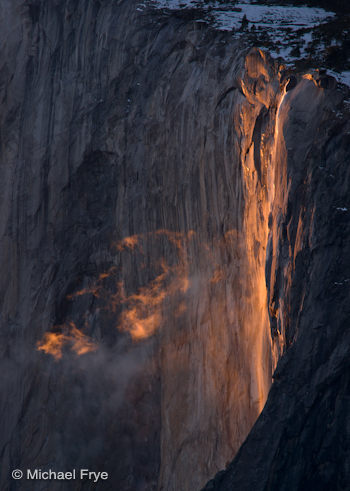
Horsetail Fall, 5:27 p.m., Wednesday, February 15th
First, a reminder that this is the last day to get a discount on my new eBook, Exposure for Outdoor Photography. Until midnight tonight you can use the code EXPOSURE4 at checkout to get the book for only 4 dollars. Or use the code EXPOSURE20 to get 20 percent off if you buy five or more Craft & Vision eBooks—including my previous volume, Light & Land: Landscapes in the Digital Darkroom.
Now, on to Horsetail Fall. Yosemite Valley received about four inches of snow on Tuesday night, and higher elevations got a little bit more. Unfortunately that precipitation did little to improve the water volume in Horsetail Fall. It’s flowing, but barely. Yet it’s amazing how little water it actually takes. You can strain your eyes to detect any flow at all for most of the day, and then as the sun lowers it highlights the fall perfectly and makes whatever water there is stand out.
The accompanying photographs were made on Wednesday and Thursday evenings while I was teaching private workshops, and show the current conditions pretty well. On Wednesday some mist drifted past the fall, adding interest, but distant clouds dimmed the light before it reached its most intense color. On Thursday, the light was about as good as it gets for Horsetail, lasting right until the theoretical sunset time, with the cliff behind the fall shaded. If only there was more water!
(more…)
by Michael Frye | Feb 12, 2012 | Yosemite Photo Conditions
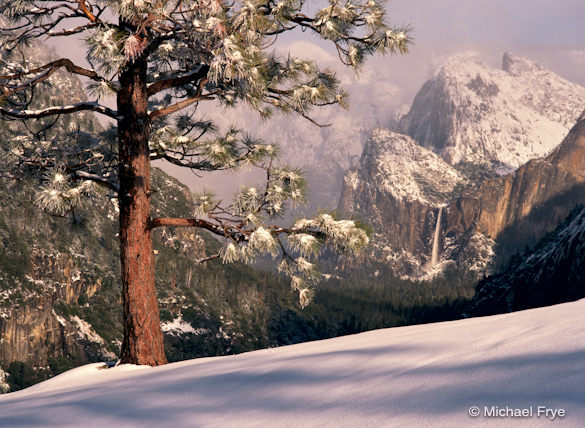
February light on Bridalveil Fall from near Turtleback Dome
First, I’m going to have a big announcement later this week—stay tuned!
Next, I’ve been getting lots of questions about Horsetail Fall. Since my last post about this not much has changed; there is little water in Horsetail right now. There’s snow in the forecast for tonight and tomorrow, so that should help, but they’re only predicting 6-8 inches, and I don’t know whether that will be enough to make a significant difference. If the weather warms immediately afterward and melts some of that new snow the water volume could get a bump, but it’s likely to be short-lived.
But there are other things to photograph in Yosemite in February. That storm is predicted to be a cold one, which means fresh snow in Yosemite Valley. And when the storm ends we could see some nice clearing storm conditions.
(more…)










